Effect of Nanoparticles on the Morphology, Thermal, and Electrical Properties of Low-Density Polyethylene after Thermal Aging
Abstract
:1. Introduction
2. Experiment
2.1. Materials
2.2. Sample Preparation
2.3. Scanning Electron Microscope Imaging
2.4. FTIR Analysis
2.5. Thermogravimetric Analysis (TGA)
2.6. Space Charge Measurments
2.7. Dielectric Properties
3. Results and Discussion
3.1. SEM Morphology
3.2. FTIR Spectra
3.3. TGA Analysis
3.4. Space Charge Distribution
3.5. Dielectric Properties
4. Conclusions
- (1)
- In comparison with SiO2 nanoparticles, MgO nanoparticles have the ability to protect the structure of the polyethylene matrix and delay the appearance of thermo-oxidative reactions during thermal aging. Furthermore, LDPE/MgO and LDPE/SiO2 nanocomposites have better thermal stabilization than neat LDPE.
- (2)
- Nanocomposites have the ability to suppress space charge accumulation after thermal aging and the mean volume charge density of nanocomposites ranged from 0–1 C/m3 before and after thermal aging, which is much smaller than that of neat LDPE. It is suggested that the interface between nanoparticles and the polymer matrix may be the main reason for the suppression of space charge of nanocomposites.
- (3)
- Neat LDPE and LDPE/SiO2 nanocomposites show much higher permittivity, which reach 3.3 and 3.8 with the aging time of 77 days, and more obvious relaxation peaks after thermal aging. The fitting results reveal that DC conductivity and the hopping of ions increase sharply after thermal aging. However, due to the anti-thermal aging ability of LDPE/MgO nanocomposites, the permittivity and DC conductivity change slightly during thermal aging, showing better insulation properties after thermal aging.
Acknowledgments
Author Contributions
Conflicts of Interest
References
- Mazzanti, G.; Montanari, G.C.; Palmieri, F.; Alison, J. Apparent trap-controlled mobility evaluation in insulating polymers through depolarization characteristics derived by space charge measurements. J. Appl. Phys. 2003, 94, 5997–6004. [Google Scholar] [CrossRef]
- Sugimoto, M.; Shimada, A.; Kudoh, H.; Tamura, K.; Seguchi, T. Product analysis for polyethylene degradation by radiation and thermal ageing. Radiat. Phys. Chem. 2013, 82, 69–73. [Google Scholar] [CrossRef]
- Rana, D.; Mandal, B.M.; Bhattacharyya, S.N. Analogue calorimetric studies of blends of poly(vinyl ester)s and polyacrylates. Macromolecules 1996, 29, 1579–1583. [Google Scholar] [CrossRef]
- Rana, D.; Mandal, B.M.; Bhattacharyya, S.N. Analogue calorimetry of polymer blends: Poly(styrene-co-acrylonitrile) and poly(phenyl acrylate) or poly(vinyl benzoate). Polymer 1996, 37, 2439–2443. [Google Scholar] [CrossRef]
- Cavallaro, G.; Danilushkina, A.A.; Evtugyn, V.G.; Lazzara, G.; Milioto, S.; Parisi, F.; Rozhina, E.V.; Fakhrullin, R.F. Halloysite nanotubes: Controlled access and release by smart gates. Nanomaterials 2017, 7, 199. [Google Scholar] [CrossRef] [PubMed]
- Bertolino, V.; Cavallaro, G.; Lazzara, G.; Lazzara, G.; Milioto, S.; Parisi, F.; Rozhina, E.V.; Fakhrullin, R.F. Effect of the biopolymer charge and the nanoclay morphology on nanocomposite materials. Ind. Eng. Chem. Res. 2016, 55, 7373–7380. [Google Scholar] [CrossRef]
- Calebrese, C.; Le, H.; Schadler, L.S.; Nelson, J.K. A review on the importance of nanocomposite processing to enhance electrical insulation. IEEE Trans. Dielectr. Electr. Insul. 2011, 18, 938–945. [Google Scholar] [CrossRef]
- Khodaparast, P.; Ounaies, Z. Influence of dispersion states on the performance of polymer-based nanocomposites. Smart Mater. Struct. 2014, 23, 104004. [Google Scholar] [CrossRef]
- Lau, K.Y.; Vaughan, A.S.; Chen, G.; Hosier, I.L.; Holt, A.F. On the dielectric response of silica-based polyethylene nanocomposites. J. Phys. D Appl. Phys. 2013, 46, 095303. [Google Scholar] [CrossRef]
- Bao, S.P.; Liang, G.D.; Tjong, S.C. Effect of mechanical stretching on electrical conductivity and positive temperature coefficient characteristics of poly(vinylidene fluoride)/carbon nanofiber composites prepared by non-solvent precipitation. Carbon 2011, 49, 1758–1768. [Google Scholar] [CrossRef]
- Zhang, L.; Zhou, Y.; Cui, X.; Sha, Y.; Le, T.H.; Ye, Q.; Tian, J. Effect of nanoparticle surface modification on breakdown and space charge behavior of XLPE/SiO2 nanocomposites. IEEE Trans. Dielectr. Electr. Insul. 2014, 21, 1554–1564. [Google Scholar] [CrossRef]
- Dang, Z.M.; Yao, S.H.; Xu, H.P. Effect of tensile strain on morphology and dielectric property in nanotube/polymer nanocomposites. Appl. Phys. Lett. 2007, 90, 012907. [Google Scholar] [CrossRef]
- Huang, X.; Xie, L.; Yang, K.; Wu, C.; Jiang, P.; Li, S.; Wu, S.; Tatsumi, K.; Tanaka, T. Role of interface in highly filled epoxy/BaTiO3 nanocomposites. Part I—Correlation between nanoparticle surface chemistry and nanocomposite dielectric property. IEEE Trans. Dielectr. Electr. Insul. 2014, 21, 467–479. [Google Scholar] [CrossRef]
- Osman, M.A.; Rupp, J.E.P. Interfacial Interactions and Properties of Polyethylene-Layered Silicate Nanocomposites. Macromol. Rapid Commun. 2010, 26, 880–884. [Google Scholar] [CrossRef]
- Smith, R.C.; Liang, C.; Landry, M.; Nelson, J.K.; Schadler, L.S. The mechanisms leading to the useful electrical properties of polymer nanodielectrics. IEEE Trans. Dielectr. Electr. Insul. 2008, 15, 187–196. [Google Scholar] [CrossRef]
- Tanaka, T.; Kozako, M.; Fuse, N.; Ohki, Y. Proposal of a multi-core model for polymer nanocomposite dielectrics. IEEE Trans. Dielectr. Electr. Insul. 2005, 12, 669–681. [Google Scholar] [CrossRef]
- Vyazovkin, S.; Dranca, I.; Fan, X.; Advincula, R. Kinetics of the Thermal and Thermo-Oxidative Degradation of a Polystyrene–Clay Nanocomposite. Macromol. Rapid Commun. 2010, 25, 498–503. [Google Scholar] [CrossRef]
- Omastová, M.; Podhradská, S.; Prokeš, J.; Janigová, I.; Stejskal, J. Thermal ageing of conducting polymeric composites. Polym. Degrad. Stab. 2003, 82, 251–256. [Google Scholar] [CrossRef]
- Khabbaz, F.; Albertsson, A.C.; Karlsson, S. Chemical and morphological changes of environmentally degradable polyethylene films exposed to thermo-oxidation. Polym. Degrad. Stab. 1999, 63, 127–138. [Google Scholar] [CrossRef]
- Kupai, J.; Razali, M.; Buyuktiryaki, S.; Kecili, R.; Szekely, G. Long-term stability and reusability of molecularly imprinted polymers. Polym. Chem. 2016, 8, 666–673. [Google Scholar] [CrossRef] [PubMed]
- Barroso-Bujans, F.; Alegría, A.; Pomposo, J.A.; Colmenero, J. Thermal stability of polymers confined in graphite oxide. Macromolecules 2013, 46, 1890–1898. [Google Scholar] [CrossRef]
- Lindsay, G.A.; Guenthner, A.J.; Wright, M.E.; Sanghadasa, M.; Ashley, P.R. Multi-month thermal aging of electro-optic polymer waveguides: Synthesis, fabrication, and relaxation modeling. Polymer 2007, 48, 6605–6616. [Google Scholar] [CrossRef]
- Gabrielle, B.; Lorthioir, C.; Lauprêtre, F. Thermal aging of interfacial polymer chains in ethylene-propylene-diene terpolymer/aluminum hydroxide composites: Solid-state NMR study. J. Phys. Chem. B 2011, 115, 12392–12400. [Google Scholar] [CrossRef] [PubMed]
- Bouguedad, D.; Jbara, O.; Rondot, S.; Mekhaldi, A.; Hadjadj, A. Investigation of accelerated thermal aging of EPDM polymer by electric tests in air and by means of a SEM technique in high vacuum. IEEE Trans. Dielectr. Electr. Insul. 2012, 19, 981–989. [Google Scholar] [CrossRef]
- Wang, Y.; Xia, X.; Xiao, C.; Tamura, K.; Seguchi, T. Anti-aging properties of the Cu/LDPE composite for intrauterine contraceptive devices. Compos. Sci. Technol. 2014, 90, 139–146. [Google Scholar] [CrossRef]
- Esthappan, S.K.; Kuttappan, S.K.; Josepha, R. Effect of titanium dioxide on the thermal ageing of polypropylene. Polym. Degrad. Stab. 2012, 97, 615–620. [Google Scholar] [CrossRef]
- Wang, Y.; Shen, H.; Li, G.; Mai, K. Crystallization and melting behavior of PP/CaCO3, nanocomposites during thermo-oxidative degradation. J. Ther. Anal. Calorim. 2010, 100, 999–1008. [Google Scholar] [CrossRef]
- Ahmad, I.; Li, C.Y.; Hsuan, Y.G.; Cairncross, R.A. Reaction model describing antioxidant depletion in polyethylene–clay nanocomposites under thermal aging. Polym. Degrad. Stab. 2014, 110, 318–335. [Google Scholar] [CrossRef]
- Rana, D.; Kim, H.L.; Kwag, H.; Choe, S. Hybrid blends of similar ethylene 1-octene copolymers. Polymer 2000, 41, 7067–7082. [Google Scholar] [CrossRef]
- Rana, D.; Kim, H.L.; Kwag, H.; Rhee, J.; Cho, K.; Woo, T.; Lee, B.H.; Choe, S. Blends of ethylene 1-octene copolymer synthesized by Ziegler–Natta and metallocene catalysts. II. Rheology and morphological behaviors. J. Appl. Polym. Sci. 2000, 76, 1950–1964. [Google Scholar] [CrossRef]
- Wang, Y.; Wang, C.; Xiao, K. Investigation of the electrical properties of XLPE/SiC nanocomposites. Polym. Test. 2016, 50, 145–151. [Google Scholar] [CrossRef]
- Takada, T.; Hayase, Y.; Tanaka, Y.; Okamoto, T. Space charge trapping in electrical potential well caused by permanent and induced dipoles for LDPE/MgO nanocomposite. IEEE Trans. Dielectr. Electr. Insul. 2007, 15, 152–160. [Google Scholar] [CrossRef]
- Min, D.; Li, S.; Hirai, N.; Ohki, Y. Dielectric spectroscopic analysis of degradation in ethylene-propylene-diene copolymer. IEEE Trans. Dielectr. Electr. Insul. 2017, 23, 3620–3630. [Google Scholar] [CrossRef]
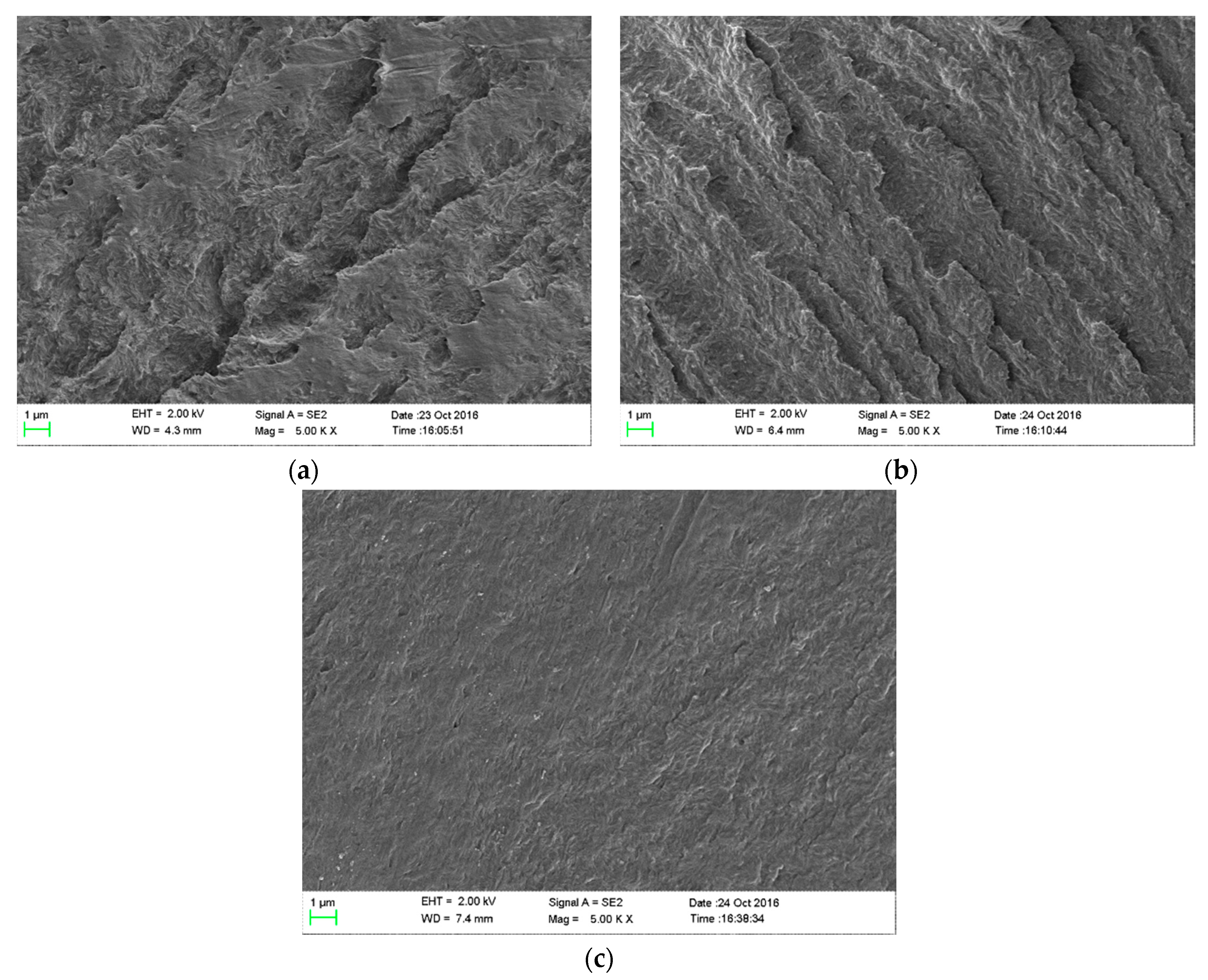
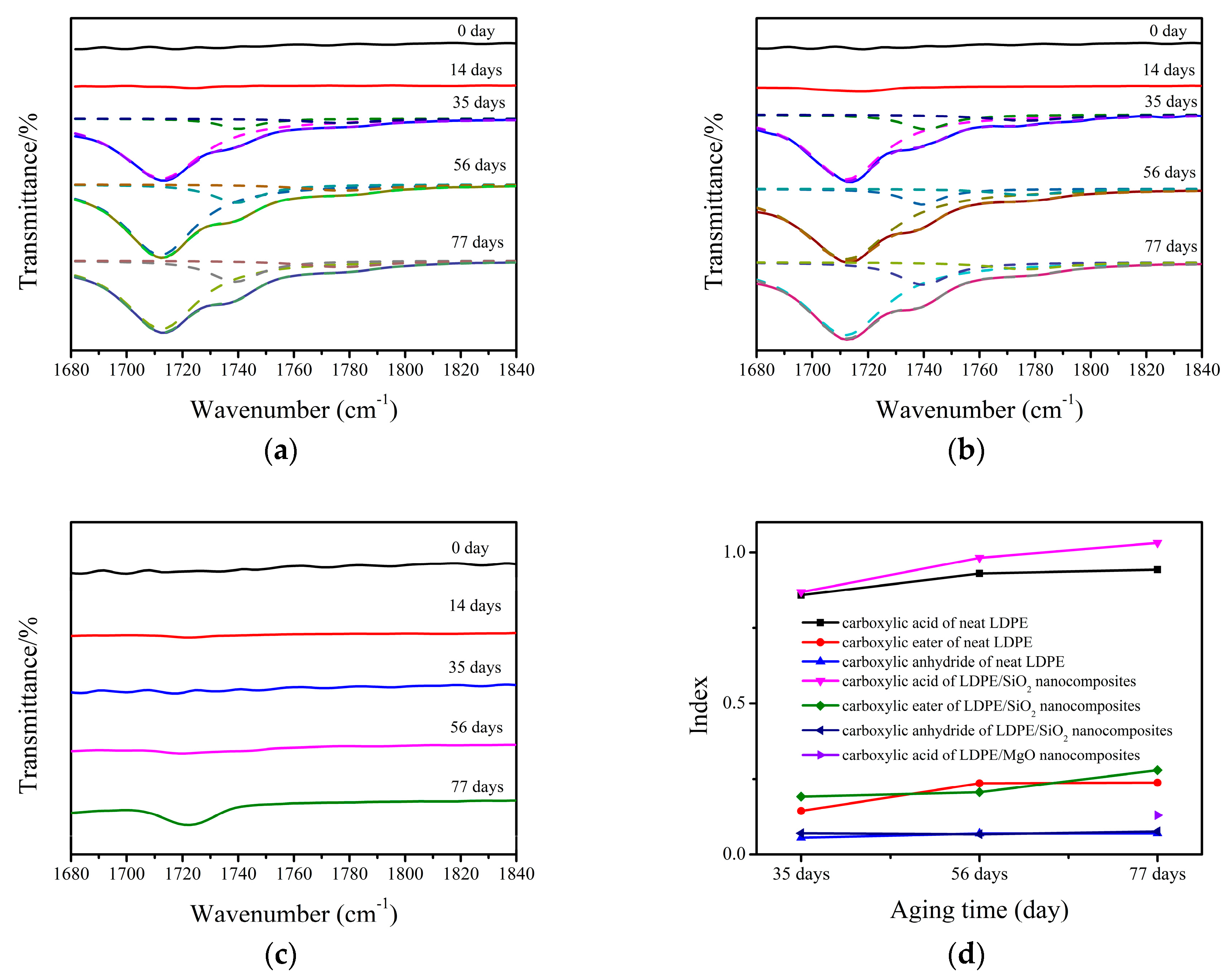
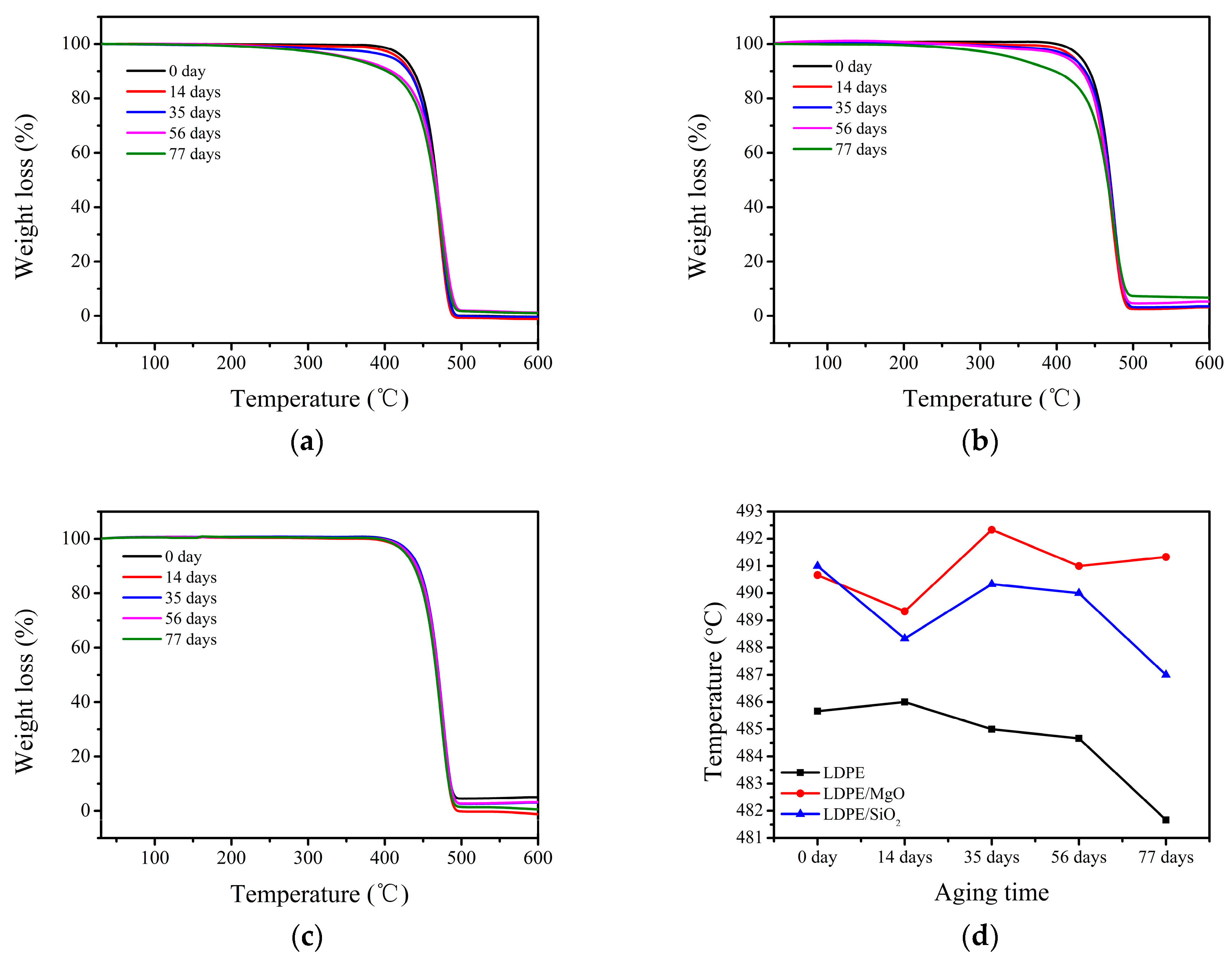

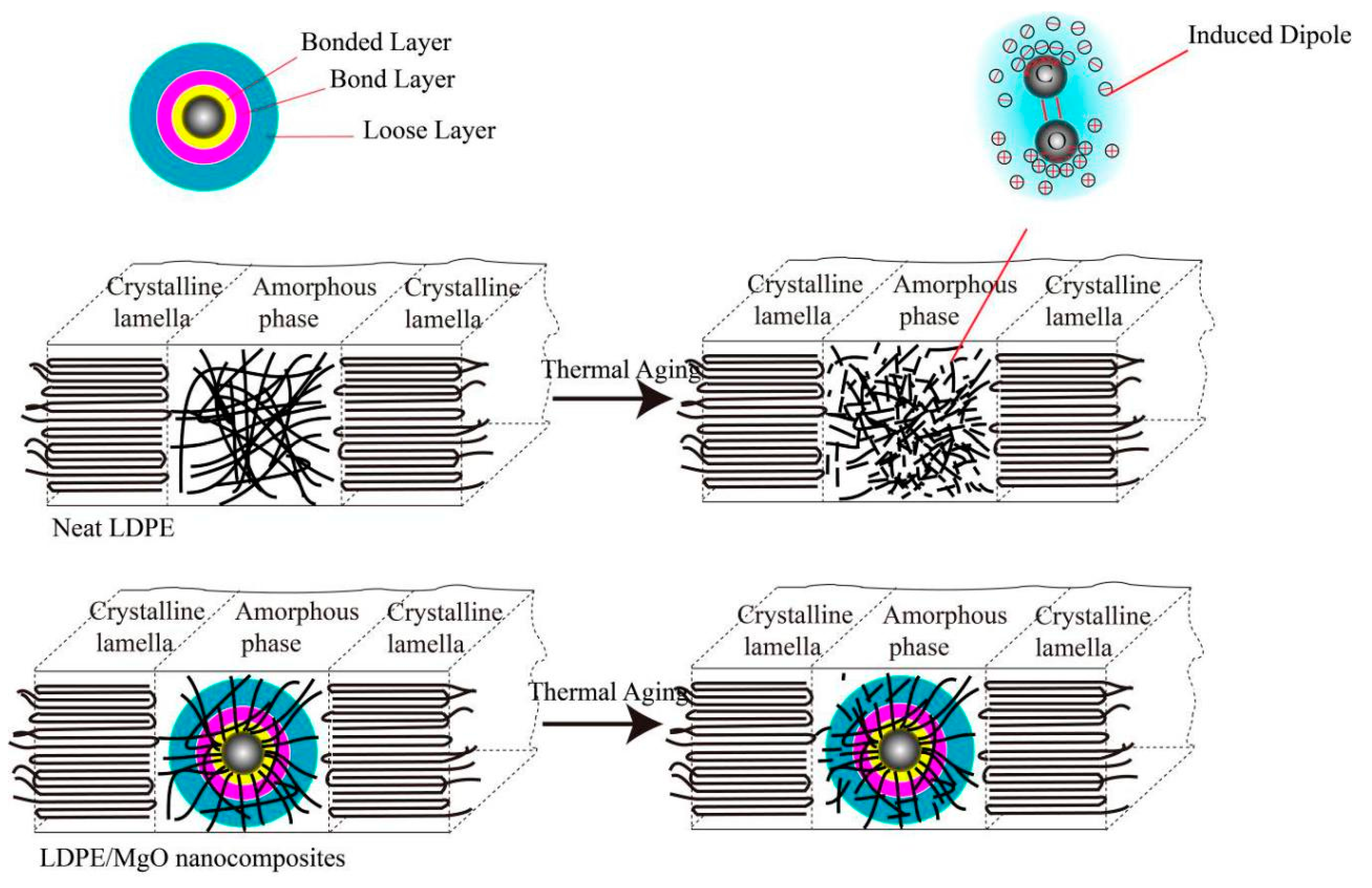
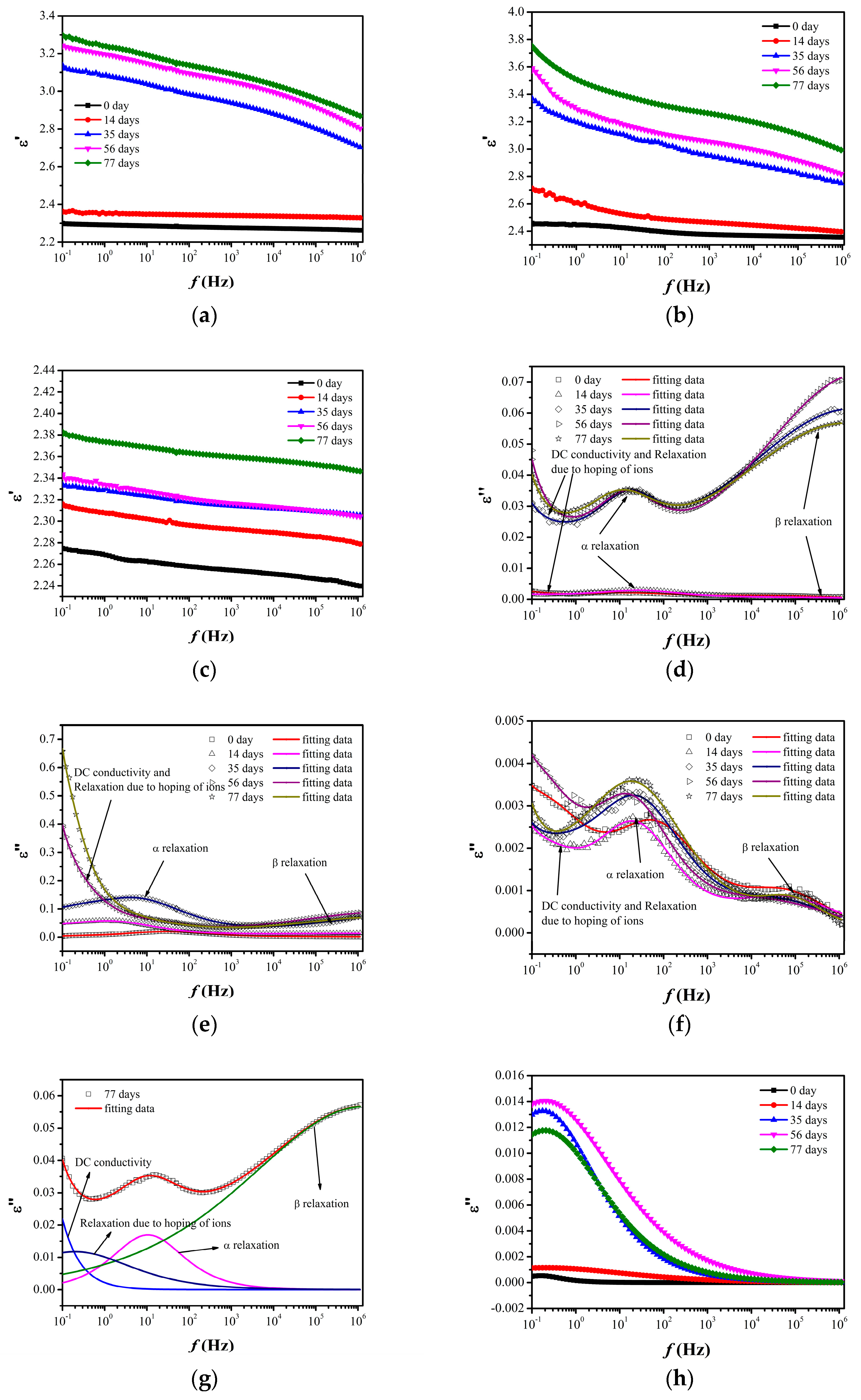

| Aging Time | σdc-Neat LDPE | σdc-LDPE/SiO2 | σdc-LDPE/MgO |
|---|---|---|---|
| 0 day | 7.65 × 10−15 | 1.02 × 10−16 | 4.70 × 10−15 |
| 14 days | 1.75 × 10−15 | 2.50 × 10−14 | 5.55 × 10−15 |
| 35 days | 6.74 × 10−14 | 1.24 × 10−13 | 4.75 × 10−15 |
| 56 days | 1.50 × 10−13 | 1.47 × 10−12 | 7.18 × 10−15 |
| 77 days | 1.22 × 10−13 | 2.59 × 10−12 | 9.07 × 10−15 |
© 2017 by the authors. Licensee MDPI, Basel, Switzerland. This article is an open access article distributed under the terms and conditions of the Creative Commons Attribution (CC BY) license (http://creativecommons.org/licenses/by/4.0/).
Share and Cite
Wang, Y.; Wang, C.; Zhang, Z.; Xiao, K. Effect of Nanoparticles on the Morphology, Thermal, and Electrical Properties of Low-Density Polyethylene after Thermal Aging. Nanomaterials 2017, 7, 320. https://doi.org/10.3390/nano7100320
Wang Y, Wang C, Zhang Z, Xiao K. Effect of Nanoparticles on the Morphology, Thermal, and Electrical Properties of Low-Density Polyethylene after Thermal Aging. Nanomaterials. 2017; 7(10):320. https://doi.org/10.3390/nano7100320
Chicago/Turabian StyleWang, Youyuan, Can Wang, Zhanxi Zhang, and Kun Xiao. 2017. "Effect of Nanoparticles on the Morphology, Thermal, and Electrical Properties of Low-Density Polyethylene after Thermal Aging" Nanomaterials 7, no. 10: 320. https://doi.org/10.3390/nano7100320






